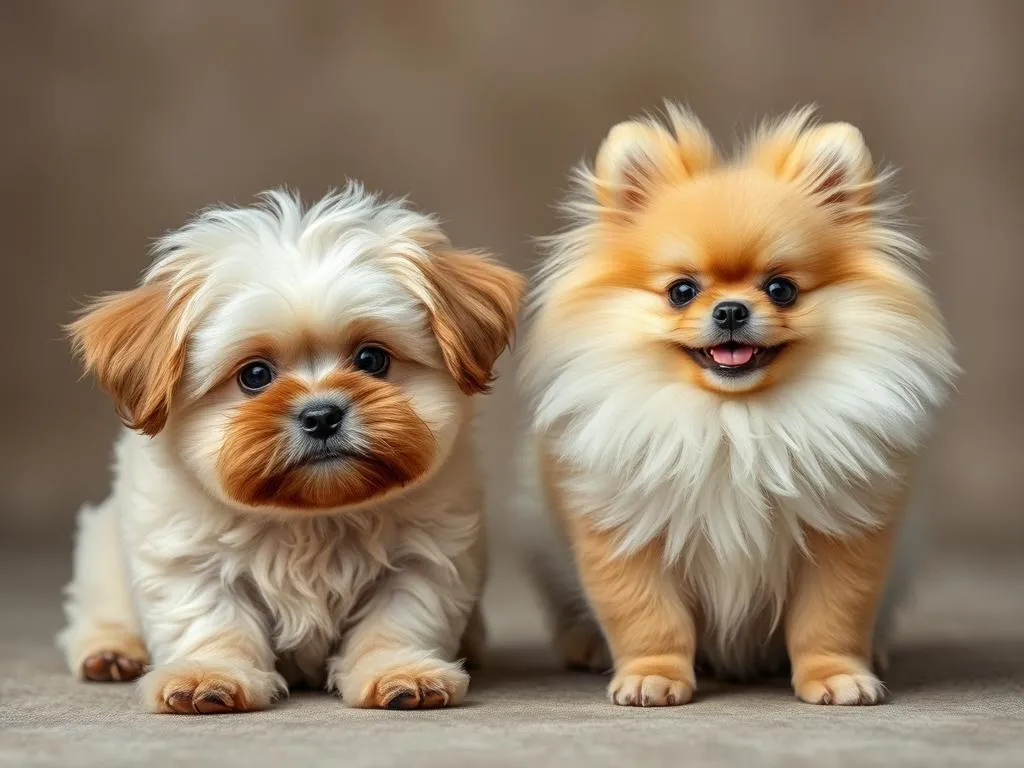
Small dog breeds have surged in popularity over the years, captivating dog lovers with their charming personalities and manageable sizes. Among the most favored options are the Maltipoo and the Pomeranian. Both breeds boast endearing qualities and unique characteristics that make them appealing to various owners. Understanding their differences is crucial for prospective dog owners, as these distinctions can greatly influence lifestyle compatibility, grooming needs, and training requirements.
Overview of Maltipoo
Origin and History
The Maltipoo is a delightful hybrid breed, resulting from the crossbreeding of a Maltese and a Poodle. This mix combines the best traits of both breeds, making the Maltipoo a popular choice among dog enthusiasts. The Maltese, known for its long, silky fur and affectionate nature, has roots dating back to ancient times in the Mediterranean region. On the other hand, the Poodle, renowned for its intelligence and versatility, was originally bred in Germany as a water retriever. The combination of these two breeds results in a delightful companion that inherits the playfulness of the Poodle and the loving nature of the Maltese.
Physical Characteristics
Maltipoos typically weigh between 5 to 20 pounds and stand about 8 to 14 inches tall at the shoulder. Their size can vary significantly based on whether a toy or miniature Poodle is involved in their lineage. The coat of a Maltipoo is often soft and curly or wavy, making it both attractive and functional. They come in a variety of colors, including white, apricot, and cream, often with markings that reflect their Poodle heritage.
Temperament and Behavior
Maltipoos are known for their friendly and affectionate personalities. They are social dogs that thrive on interaction with their families and tend to get along well with children and other pets. Their playful nature makes them a delightful addition to any household, and they often form strong bonds with their owners. However, they can be sensitive and may require gentle training approaches to avoid anxiety.
Overview of Pomeranian
Origin and History
The Pomeranian is a purebred breed that descends from larger Spitz-type dogs found in the Arctic regions. Named after the Pomerania region in Northern Europe, these dogs were bred down in size to become the companion animals we know today. Over the years, Pomeranians have gained immense popularity, especially among celebrities and socialites, due to their lively personalities and fluffy appearance.
Physical Characteristics
Pomeranians are small, typically weighing between 3 to 7 pounds and standing about 6 to 12 inches tall. Their most defining feature is their luxurious double coat, which can be fluffy and voluminous, giving them a distinctive “fox-like” appearance. Pomeranians come in a wide range of colors, including orange, black, cream, and sable, with various patterns and markings.
Temperament and Behavior
Pomeranians are known for their bold and confident personalities. They are often described as spirited and can be quite vocal, making them excellent watchdogs despite their small size. Pomeranians are generally friendly with children and other pets but can display a bit of stubbornness during training. Their playful and curious nature keeps them engaged and entertained, but they may require early socialization to prevent excessive territorial behavior.
Maltipoo vs Pomeranian: Key Comparisons
Size and Weight
When comparing the Maltipoo vs Pomeranian, size and weight are significant factors to consider. Maltipoos, depending on their Poodle parentage, can range from 5 to 20 pounds, while Pomeranians typically weigh between 3 to 7 pounds. For potential owners, this difference means that Maltipoos may need a bit more space and a larger living area to accommodate their size. Conversely, Pomeranians are more adaptable to smaller living situations, making them suitable for apartment dwellers.
Grooming Needs
Grooming is an essential part of pet ownership, and both breeds have unique requirements. Maltipoos require regular grooming to maintain their coat’s health and prevent matting. Depending on the coat’s texture, they may need to be groomed every 4 to 6 weeks. Common grooming tools include slicker brushes, combs, and dog-safe shampoos.
Pomeranians, with their double coats, also require frequent grooming to avoid tangles and matting. They shed seasonally, necessitating more regular brushing during these times to manage loose fur. A standard grooming routine for Pomeranians includes brushing at least twice a week and regular trips to a groomer for trimming.
Exercise Requirements
Both Maltipoos and Pomeranians are lively and playful, but their exercise needs can differ slightly. Maltipoos generally require moderate exercise, such as daily walks and playtime, to keep them happy and healthy. They enjoy interactive play and can adapt to various activity levels, making them suitable for both active and more laid-back owners.
Pomeranians, while also energetic, have slightly lower exercise needs. A few short walks each day and plenty of indoor playtime usually suffice to keep them satisfied. It’s essential to engage them mentally through toys and games, as their intelligence can lead to boredom if not adequately stimulated.
Health Considerations
Health is a crucial aspect when considering a dog breed. Maltipoos may inherit health issues from both parent breeds. Common concerns include dental problems, patellar luxation, and hip dysplasia. Their lifespan tends to range from 12 to 15 years, depending on their care and genetics.
Pomeranians are prone to specific health issues as well, including dental problems, hip dysplasia, and heart conditions. They generally have a lifespan of 12 to 16 years, with proper care and regular veterinary check-ups contributing to their longevity.
Training and Intelligence
Both breeds are intelligent but may have different trainability levels. Maltipoos are often eager to please, making them relatively easy to train. Positive reinforcement techniques, such as treats and praise, work well with them. Early socialization is also vital to ensure they develop into well-adjusted adults.
Pomeranians, while intelligent, can show a streak of independence or stubbornness during training. Consistent training methods and patience are essential for success. They thrive on mental stimulation and can learn a variety of tricks, but they may require more persistence and creativity in training sessions.
Lifestyle Compatibility
Ideal Living Situations
When considering Maltipoo vs Pomeranian, potential dog owners should assess their living environments. Maltipoos can adapt to various living situations, but they thrive in homes with enough space to move around and play. They are an excellent choice for families with children, as they enjoy companionship and interaction.
Pomeranians are highly adaptable and can thrive in smaller living spaces, such as apartments. Their small size and lower exercise requirements make them suitable for singles or elderly owners who may have limited mobility. They are also affectionate companions who enjoy being part of family activities.
Cost of Ownership
The financial aspect of dog ownership is also a significant consideration. The initial costs for both breeds can vary depending on factors such as breeder reputation and location. For Maltipoos, purchasing from a reputable breeder may range from $1,000 to $3,000. Initial veterinary visits, vaccinations, and spaying/neutering add to the upfront costs.
Pomeranians typically have a similar price range, ranging from $500 to $5,000, depending on pedigree and breeder. Ongoing costs for both breeds include food, grooming, and veterinary care, which can average around $500 to $1,000 annually, depending on individual needs and health considerations.
Allergies and Sensitivities
One of the most attractive features of the Maltipoo is its potential hypoallergenic qualities. The Poodle gene can contribute to reduced shedding, making them a suitable choice for allergy sufferers. However, it’s essential to note that no dog is entirely hypoallergenic, so potential owners should spend time with the breed to gauge their reactions.
In contrast, Pomeranians are known to shed, especially during seasonal changes. This shedding can be a consideration for individuals with allergies. Regular grooming can help manage loose fur, but those with severe allergies might find it challenging to coexist with Pomeranians.
Conclusion
In summary, both the Maltipoo and the Pomeranian offer unique characteristics that appeal to various dog owners. The Maltipoo’s friendly demeanor and adaptability make it an excellent family pet, while the Pomeranian’s spirited personality and smaller size cater to those in apartments or smaller homes. Understanding the key differences—such as size, grooming needs, exercise requirements, health considerations, and training—is essential for making an informed decision.
Ultimately, choosing between a Maltipoo and a Pomeranian depends on personal lifestyle, living situations, and preferences. Prospective dog owners should consider their daily routines, family dynamics, and financial commitments before welcoming a new furry friend into their home. Both breeds have the potential to bring joy, companionship, and love to their new families.









